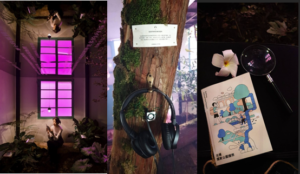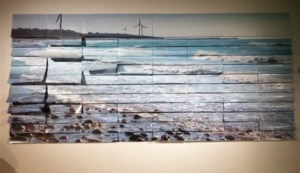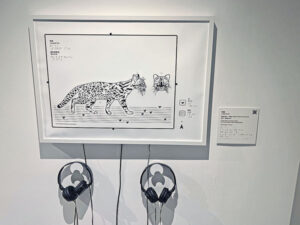Sprint 3 Beyond the Visual_Reflection
Derek Jarman’s Blue
At first, when I was watching this video, even with the background music and the voice of people talking, the constant blue screen made me unable to concentrate. However, I was curious about why it was blue and not other colors, so I searched for the director’s motivation to create it, even though my thoughts might be influenced by subjective emotions and become less pure. The director lost his eyesight due to AIDS and was overshadowed by death, but he did not give up creating, and this was the last work of his life and the last poem he contributed to the world. I didn’t know that the director made this film for such a heavy reason, and it did change my mind. I became able to focus on the screen and wanted to understand the content of the film.
I don’t fully agree with Jenna Carine Ashton’s statement because blue is symbolic in this film, it’s not a blank canvas. What’s more, the human sensory systems coexist and interact so that people can listen and see at the same time. Unless my vision is deprived, it is difficult for me to ignore the objects in my field of vision. When people engage with most artworks, they are attracted to sight first, and then the other senses. But it is actually difficult for people to interpret them through vision alone, and there is no way to understand the meanings of the works just by looking at them. In my case, when I look at artworks, I can only develop a relationship with the subject if I understand the ideas behind them and combine my own experiences.
The human perception system is established by the five physical senses (sight, hearing, smell, touch, and taste). The world is full of sensations, and the senses have become an important medium for our contact with the outside world. Our perceptions define the boundaries of our consciousness, and humans seem to be inherently natural explorers, extending our perceptions as far as possible to reach the wider world. Nevertheless, with the establishment and development of visual culture, people focus on the progress of visual ability, and then forget other senses, making our sensory world become single and boring.
According to research on the proportion of five senses used, it was found that in the modern world led by ocularcentrism, the proportion of senses other than vision is very low. And people’s sensory world seems to be bound in the monotonous world of only vision. Japanese color scholar Junichi Nomura mentioned in his book The Secret of Color that the proportions of the five senses are: 87% for sight, 7% for hearing, 3% for touch, 2% for smell, and 1% for taste. It can be seen that 80% to 90% of human information is obtained by sight. Conversely, it can also be said that we are so dependent on our eyes that we even think that the world we see with our eyes is everything. Even if it is physically the same material or space, “seeing through the eyes” and “contacting with other than the eyes” will have completely different appearances. It’s just that most of us are too dependent on the vision that we miss another face of the world.
Running Taoyuan
The 2020 Taoyuan Cultural Expo was held in Matsu New Village, which is rich in cultural memory. The curatorial team created a landscape of Taoyuan’s mountains and forests through material symbols related to the senses. Entering the exhibition, through the perception of the five senses, people could see, touch, smell, and listen to the breath of the mountains and the coast. The immersive experience seemed to truly enter the mountains and seaside of Taoyuan. People connected society through the medium of senses, and constructed different aspects of culture. Through the sensory symbols and images in culture, they reproduced the physical objects in the exhibition venue and connected them to the abstract immaterial objects in the heart through the sensory interface. Formed a new city image and reproduced culture in the exhibition space. A new physical experience is created in the field, which is a very interesting transformation process.


Beyond Nature Project
Beyond Vision International is a non-profit organization for visually impaired people to gain access to art and culture. The 13% of the Thousand Worlds exhibition showcased the process and attempt of the Beyond Nature Project, recording the journey of visually impaired people becoming ecological docents. Because 87% of the sensory information received by humans comes from sight, while the remaining 13% is a combination of hearing, smell, taste, and touch, hence the exhibition was named 13% of the Thousand Worlds. The exhibition featured different installations, documentaries, and panels, including a bird-watching experience installation, which simulated a bird-watching house with oral explanations and tactile images from docents. The exhibition also extracted characteristics of Mai Po and Yuen Chau Tsai and transformed them into the Tactile-Auditory Interaction System (TAIS).


Many people with disabilities cannot see or hear, but other senses are stronger than ours. Blind people, or visually impaired people, are actually experts at perceiving another face of the world. For example, they can know the direction of the texture of the tatami from the touch of the soles of their feet and thus detect the position of the walls of the room. They can judge whether the curtains are opened by the strong and weak reflection of the echo, and infer the approximate time by sound of traffic and people from outside. The information that each blind person can perceive may be different, but it is very natural and normal for them to use these abilities. Congenitally blind people are not only unable to visually recognize the things in front of them, but also difficult to understand the visual images that constitute human art and culture. Therefore, the cultural filters that people who can see naturally form when they look at objects don’t affect them.
Although we exist in a world where vision is paramount, our sensory experience is both collective and individual. It is definitely not a single perception medium but a totality of common perception. I think the most important thing is not how much information we can obtain through our senses and our brains, but how to convert the information into useful meanings for ourselves according to our personal needs. Once the way of cognition is changed, blind is not a lack but a difference, and even becomes a door to open new ideas and potentials, creating more diverse and delicate imagination and discovery.




The author talks about her learning and thinking process in this sprint. I agree with the author that “It’s just that most of us are too dependent on the vision that we miss another face of the world.” As I ignored the vision and focused on the other senses during this course, I experienced many feelings that I had not experienced before. The projects cited by the author of Running Taoyuan and the Beyond Nature Project allowed me to learn more about the work done by organisations in going beyond vision with their outcomes. Thanks to the author for sharing.